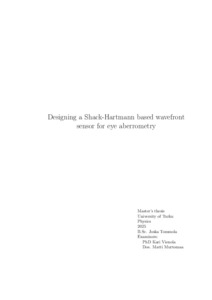Designing a Shack-Hartmann based wavefront sensor for eye aberrometry
Tommola, Joska (2025-10-10)
Designing a Shack-Hartmann based wavefront sensor for eye aberrometry
Tommola, Joska
(10.10.2025)
Julkaisu on tekijänoikeussäännösten alainen. Teosta voi lukea ja tulostaa henkilökohtaista käyttöä varten. Käyttö kaupallisiin tarkoituksiin on kielletty.
avoin
Julkaisun pysyvä osoite on:
https://urn.fi/URN:NBN:fi-fe20251111107032
https://urn.fi/URN:NBN:fi-fe20251111107032
Tiivistelmä
The focus of this thesis was to design and build a low-cost SH-WFS based imaging device to do ocular aberrometry. One of the most remarkable disadvantages of building your own Shack-Hartmann Wavefront Sensor (SHWFS) is the costs, and this study tries to find out if it is possible to use cheaper components and get reliable results. In addition to off-the-shelf components, 3D modeling and printing is utilized to design custom components for the system.
The measurements of aberrations are closely related to the wavefronts. The wavefront is the shape of a light wave, and every point of it has the same phase. If the measured wavefront deviates from the reference it means the presence of aberration which are determinated as Zernike polynomials. SHWFS is used as a sensor to measure the locations of light spots, and this plays a crucial role in determining aberrations because aberrations are based on the displacements of light spots from reference positions. SH-WFS was chosen for wavefront detection due to its simplicity and broad use in ophthalmology and astronomy.
Before building the optical system, several different parameters had to be calculated, such as the optimal wavelength of the imaging beam, the used optical power and diameter of the beam entering the eye. The parameters create a background for the building, analysis and measurements of the aberrometer. Besides all these parameters, the functionality of individual components was tested (light source, neutral density filters, trial lenses and imaging sensor).
The theory and the experimental results are in good agreement. The spot size in the measurements was 39.94-41.14 μm and theoretical calculation was 40.4 μm. The size of the spot means the diameter of the spot in the lenslet. The quality of the spots was also good because the single spots were well fitted by Gaussian functions. The best signal-to-noise ratio was applied with an exposure time of 2.5 ms. Wavefront maps showed logically increasing defocus aberration with negative trial lenses. The positive trial lenses gave unreliable results, and it is probably due to the inappropriate trial lens holder for them. The work presented in this thesis shows that it is possible to construct a low-cost aberrometer with off-the-shelf components and obtained results have laid the groundwork for future development of the device.
The measurements of aberrations are closely related to the wavefronts. The wavefront is the shape of a light wave, and every point of it has the same phase. If the measured wavefront deviates from the reference it means the presence of aberration which are determinated as Zernike polynomials. SHWFS is used as a sensor to measure the locations of light spots, and this plays a crucial role in determining aberrations because aberrations are based on the displacements of light spots from reference positions. SH-WFS was chosen for wavefront detection due to its simplicity and broad use in ophthalmology and astronomy.
Before building the optical system, several different parameters had to be calculated, such as the optimal wavelength of the imaging beam, the used optical power and diameter of the beam entering the eye. The parameters create a background for the building, analysis and measurements of the aberrometer. Besides all these parameters, the functionality of individual components was tested (light source, neutral density filters, trial lenses and imaging sensor).
The theory and the experimental results are in good agreement. The spot size in the measurements was 39.94-41.14 μm and theoretical calculation was 40.4 μm. The size of the spot means the diameter of the spot in the lenslet. The quality of the spots was also good because the single spots were well fitted by Gaussian functions. The best signal-to-noise ratio was applied with an exposure time of 2.5 ms. Wavefront maps showed logically increasing defocus aberration with negative trial lenses. The positive trial lenses gave unreliable results, and it is probably due to the inappropriate trial lens holder for them. The work presented in this thesis shows that it is possible to construct a low-cost aberrometer with off-the-shelf components and obtained results have laid the groundwork for future development of the device.
